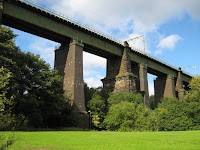Day Trip to Glossop For a Sixpence
The summer is now not to far away, however, day trippers continuously pour into our town throughout the year. Things have not changed for well over a century because last summer I found a column in the Glossop Advertiser back in 1912, by a local columnist expressing his feelings about day trippers who came from Manchester to Glossop for a sixpence.
"The summer season is now in full swing, that especially as regards the running into Glossop of cheap excursion trains on Sundays is concerned, a note of warning should be thrown out to certain visitors of both sexes who come into this pleasant Derbyshire town. Let it be clearly understood that there is not the slightest desire to put forth any argument against the introduction into Glossop of trippers. But we echo the public feeling that those cheap excursionists should behave themselves and that failing to do so the law should step in and administer a lesson not readily forgotten. It seems to have occurred to the minds of say Mancunian visitors that they are at liberty to turn Glossop into a bear garden and we are bound to say that the local justices have not as a rule made ‘the punishment fit the crime’.

It is true that, as the greatest of England’s poets says, “The quality of mercy is not strained”. That is the rule, but to most rules there are exceptions and we are inclined to believe that with regard to Sunday delinquents brought before the Glossop Police Court the merciful quality has distinctly been strained. There is a considerable proportion of these sixpenny trippers that can fairly and honestly be designated a nuisance. If people wish to escape on the Sunday from Manchester or elsewhere to healthful Glossop we admire their decision, but having arrived in the town, having availed themselves of the privilege of cheap access thereto, having left a smoke-begrimed city for the delights which Nature affords, the least they can do is to conduct themselves with propriety. But many of them do not, and they should be taught to recognise the force of the law.
Damaging grass lands, breaking trees, card playing, footballing in the public streets, and so on, are items of objectionable amusement that have been practised by a certain class of visiting hooligans, whose absence would be far preferable to their company. We want to see established by the magistracy the preservation of Glossop’s good name, and therefore we hope that stringent penalties will be in future imposed upon all offenders. Readers who revert to the report in other columns of this issue of the ‘Advertiser’ of the proceedings in the Glossop Police Court will see that the local Justices have made up their minds to stand no further nonsense. Their decision is quite right and proper, and we commend them for having arrived at it. The police have done, and are doing, their level best to stamp out the illegal and unwarrantable doings of the class of persons to whom we have so pointedly alluded. It has been pretty well accepted as a truism that there is a black sheep in every flock. Biblical instruction shows the vast difference and distinction between the sheep and the goats. In Glossop the sheep from Manchester are always sure of a cordial welcome, the goats – well, may either stay at home, or be sure either of being substantially fined or relegated to one of His Majesty’s hotels, which are usually designated by another expression."
Have things changed?
Complied by Matthew Cox








